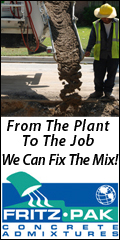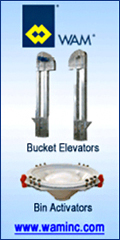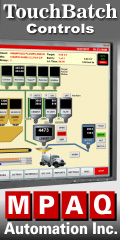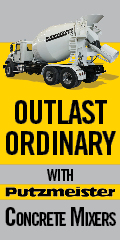NRMCA e-news
National Ready Mixed Concrete Association
NEWS LINKS
A New Jersey state legislator has introduced a bill that would require any state agency to use pervious concrete "wherever appropriate" including access roads, pathways, roadways and parking lots. The New Jersey Department of Environmental Protection would be charged with adopting criteria for the use of pervious concrete on state projects. The legislator, Assembly Republican Whip Scott T. Rumana, said using pervious concrete is part of "smart environmental, fiscal and planning policy..."
Source: December 11 posting on AggregateResearch.com. Read more.
Construction spending was up 9.6% from year-ago levels in October, based on an analysis by the Associated General Contractors of America. "Widespread gains in spending in October, along with hefty upward revisions to estimates for the previous two months, show that construction has finally come out of its long slump," said Ken Simonson, AGC's chief economist. Denver is one example of a city seeing a building boom.
Source: The AGC SmartBrief e-newsletter for December 10 which included this story from the Fox television affiliate in Denver.
The Canadian Concrete Masonry Producers Association says safety and not wood should be the first priority when it comes to construction. The association made its remarks following a report released recently by the City of Halifax recommending the use of wood as a first choice in municipal building construction. Spearheaded by Halifax City Councilor Jennifer Watts, the report says that environmentally, wood building materials "have lower energy, water and air quality impacts than alternatives," while economically, the use of wood would benefit Nova Scotia's forestry and lumber sectors — "mainstays" of the provincial economy.
Source: A press release by PR Newswire, which was posted on the Web site of The Sacramento (CA) Bee on December 7.
The name Oscar Niemeyer might not ring a bell, but perhaps no man has ever utilized concrete as well as he to shape beautiful buildings. The famed architect died recently in South America at the age of 104. His legacy included the Brazilian capital of Brasilia. The Web site of Conde Nast Traveler posted this December 6 article as a eulogy.
PROMOTIONS
NRMCA Senior National Resource Director Phil Kresge recently participated in the Ohio Ready Mixed Concrete Association (ORMCA) 2012 Concrete Pavements Seminar in Columbus. His presentation focused on incorporating alternate pavement designs to provide opportunities for concrete parking lots. Kresge included a review of recent successes within the NRMCA National Accounts program. An overview of the Design Assistance Program and the role it has played in these successes was also discussed.
Other topics in the seminar included Concrete Overlays, Pavement Design Details, Roller Compacted Concrete, Decorative Concrete and an Introduction to StreetPave 12. Among the 85 registrants were engineers representing several local townships. The seminar was organized and hosted by Mark Pardi, promotion director for ORMCA’s Central and Southeast regions.
For more information, contact Phil Kresge at pkresge@nrmca.org.
Recently, NRMCA Senior Director, National Resources, Doug O'Neill presented to the Connecticut offices of Terracon, an engineering consulting firm with more than 130 offices nationwide that consults on projects for several of NRMCA’s National Account clients. Accompanying O’Neill was Connecticut Concrete Promotion Council Executive Director Jim Langlois who provided the local perspective. The audience on this visit was Terracon's Geotechnical Engineering Services group which is usually responsible for pavement design recommendations.
Most designers in the Northeast are unfamiliar with ACI 330, so the presentation was met with many questions and concerns focused on topics including subbase requirements and the addition or subtraction of welded wire mesh for typical concrete parking lots, O'Neill said. NRMCA’s Design Assistance Program was offered as a way for participants to slowly get comfortable with ACI 330 by having NRMCA provide the design and joint layouts for some of their upcoming projects.
"In the end, we were invited to present ACI 330 to other offices in the New England region," O’Neill said.
Another interesting outcome of this meeting was the revelation that Terracon is working with a national retailer to review some of its concrete parking lot failures to evaluate what went wrong and what could be done to avoid future problems. O’Neill readily agreed when asked if NRMCA would be willing to assist them in the review and evaluation for its client.
For more information about bringing ACI 330 to your local design professionals, contact Doug O’Neill at doneill@nrmca.org.
One of NRMCA's most popular - and informative - promotion-focused Webinars is the remaining Webinar scheduled for December. Spending an hour discussing NRMCA's Concrete Pavement Analyst software is an hour well spent: it's designed to help your company take advantage of this growing market. To learn more and to access online registration links, see the link below or contact NRMCA's Jacques Jenkins at jjenkins@nrmca.org.
ASSOCIATION & INDUSTRY NEWS
The Winter 2012 edition of NRMCA's quarterly magazine, Concrete inFocus, has a number of timely and informative articles available only online, including this article on why recommending fibers as a temperature-shrinkage reinforcement system is a good idea. Next week, E-NEWS will highlight buyout strategies for ready mix owners.
Click here to access the entire Winter issue along with links to past issues from NRMCA's Web site.
Tom Bagsarian, managing editor of Concrete Producer magazine, announced last Wednesday the magazine’s 2012 "Industry Influencers," which include the Concrete Sustainability Hub (CSH) at the Massachusetts Institute of Technology (MIT). In selecting the MIT CSH, Bagsarian writes "The Massachusetts Institute of Technology Concrete Sustainability Hub has taken its research results to the streets only three years since starting its important work. The RMC Research and Education Foundation and the Portland Cement Association established the hub to accelerate breakthroughs in concrete science and engineering, and most importantly, to transfer that science into practice."
ENGINEERING
The following is a summary of actions at the ASTM meeting of Committees C01 on Cement and C09 on Concrete attended by NRMCA staff earlier this month in Atlanta.
C09.20 Concrete Aggregates - There was no activity on revisions to ASTM C33. Revisions were in process for C88 on soundness. Revisions were approved to C70 (moisture by displacement), C117 (passing No. 200) and C566 (moisture content of aggregate by drying) to change these standards to SI unit standards. A task group working on a specification for mineral fillers for use in concrete developed and balloted an initial proposal. Feedback from the ballot will be considered for a future ballot. This specification will support the use of mineral fillers in concrete, which may be used in self-consolidating concrete or for other purposes. A new rapid (5 minute) test method to determine the methylene blue index (MBI) of aggregate was approved at the subcommittee level and will be issued for a main committee ballot. The test is a colorimetric method and is considered to simpler, more accurate and less subjective than an existing AASHTO method. The purpose of the test is to identify the presence of active clay minerals in aggregates or in mineral fillers.
C09.24 Supplementary Cementitious Materials - The proposed revision to C618 that requires the reporting of calcium oxide (CaO) content and total alkali content of fly ash has passed the main committee and will become part of the standard by early 2013. Various terminology such as water soluble alkali, total alkali (acid soluble vs XRF) and available alkali will be discussed as new business in ASTM C311. The subcommittee discussed evolving legislative activity regarding the EPA proposal to address fly ash proposal and beneficial use.
C09.26 Chemical Reactions - The precision statement of the concrete prism test, ASTM C1293 for determining the reactivity of aggregates will be updated. The subcommittee is evaluating the accuracy to which the result has to be reported (to the nearest 0.001% or to 0.01%) relative to the typical acceptance criteria of 0.04%. It was pointed out once the reactivity of an aggregate source is established by ASTM C1260 or more preferably the more reliable ASTM C1293, ASTM C289 (chemical method) can be used as a rapid method for monitoring the reactivity of that aggregate source. New business items planned include: 1. Introduction of "as is" aggregate grading option in C1260, C1293 and C1567 tests; 2. Inclusion of C595 and C1157 cements in C1293 and C1567.
C09.40 Ready Mixed Concrete - Two significant revisions to ASTM C94 were approved: 1. a provision will permit the addition of water to concrete during transportation (with limits) in truck mixers to permit the use of equipment available and being developed that evaluates the slump of concrete and facilitates the automated and recorded addition of water to achieve target slump; 2. A new section that defines the process and requirements for verification of the accuracy of scales used for batching concrete. This revision is consistent with the process described in the NRMCA plant certification program.
A proposed revision to eliminate the 300 revolution limit on truck mixed concrete was successful in passing the subcommittee resolution process, but was held back from being approved by the C09 main committee. The comments from the previous ballot have been accommodated and the revision will be proposed for a new letter ballot. A revision was proposed to the section that deals with dispute resolution to remove the requirement to use arbitration for this purpose. The subcommittee resolved all negatives and the item will seek approval by the main committee in a future ballot.
Items in line for future revisions include changes to the air content table, several revisions to the section on batching concrete, clarifying requirements for ordering lightweight concrete, addressing reuse of fresh returned concrete more likely as a separate standard and revisions to the methods used for chemical analysis of non-potable mixing water.
C09.48 Performance of Cementitious Materials and Admixture Combinations - Based on a previous ballot, this subcommittee will revise and reballot a new practice for evaluating hydration of hydraulic cementitious mixtures using thermal measurements. The practice will provide information on using simple thermal measurements with concrete, mortar or paste specimens to evaluate early age hydration of materials combinations of cements, pozzolans, slags and chemical admixtures, with or without aggregates. This practice will be useful in determining the effects of varying combinations of materials, at specific temperatures of interest, on performance aspects such as time of set, early hydration rates and identification of abnormal hydration tendencies.
C09.49 Pervious Concrete - Four ASTM methods on pervious concrete have been standardized thus far – ASTM C1688 on Fresh Density, C1701 on Field Infiltration Rate, C1747 on Resistance to Impact and Abrasion and C1754 Hardened Density and Void Content. Several new items were discussed on all of the above methods. C1688 has undergone a number of revisions already since it was first standardized in 2008. The other two new methods that are being pursued are compressive strength and flexural strength with a final round robin and a ballot of the compressive strength test method being planned for Spring 2013.
NRMCA Vice President Karthik Obla will step down as chairman after completing his six-year term which started at the inception of this subcommittee; Matt Offenberg will take over as the new chair.
C09.50 Risk Management for Alkali Aggregate Reactions (AAR) - The new practice "Determining Reactivity of Concrete Aggregates and Minimizing Risk of Deleterious Expansion" has been balloted thrice and the latest round has received nine negatives that will result in improvements to the standard. The item was withdrawn to address these comments and will be reballoted.
C09.60 Fresh Concrete Tests - A revision was approved to the slump test method, C143, to permit the use of ABS plastic for slump cones without qualification testing. Minor revisions were approved for the air content by the volumetric method, C173. The subcommittee continues to develop a precision statement for the air content by the pressure method, C231, but there was some concern on the proposed statement based on the data from the inter-laboratory study.
Regarding the measurement of water content of fresh concrete using the microwave oven, it was indicated that the AASHTO Subcommittee on Materials would vote to drop the method and ASTM will not continue to develop its version of the method. If AASHTO does not drop the method, revisions will be proposed to the AASHTO Standard T318. The subcommittee received a presentation by Dr. Ley from the Oklahoma State University on a modified air content pressure meter test that provides an indication of the air void distribution in addition to the total air content. Dr. Ley’s research indicates that air voids tend to be of coarser size in fresh concrete containing carboxylate water reducing admixtures.
C09.61 Strength - Minor revisions were approved to C78 and C293 on testing for flexural strength and some clarification items to C617 and C1231 on capping cylinders. A new standard was approved for accelerated curing of concrete based on a portion C684 which will be replaced by this standard. Accelerating curing procedures using warm water and autogenous methods are described in this practice.
C09.66 Fluid Penetration - There are many different resistivity (bulk and surface) test methods. Under ideal conditions their results should match but they seem to differ and this was discussed. The 4 point resistivity method, referred to as the Wenner probe method, was discussed. There are at least three commercial equipment manufacturers producing devices. The devices use gels and wet sponges in contact with the concrete and the actual resistivity may be influenced by that.
C09.67 Resistance to Environment - A new version of the ASTM C672 - Scaling Test was discussed. Changes to the current version include: 1. Accelerated curing of specimens; 2. Presoaking for 7 days in sodium chloride solution followed by cycles of freezing and thawing ponded with sodium chloride solution, instead of the current calcium chloride. These changes make the test method less severe and the results correlated better with field exposure in a Canadian research project.
C01.10 Cement - A minor revision was approved to ASTM C595 on blended cement. Work is underway to reorganize C595 to improve clarity – define materials used in manufacture, simplify the table of requirements and some of the nomenclature used for blended cements. Activity is also underway to establish heat of hydration requirements for cements based on newly standardized method ASTM C1702 by isothermal calorimetry.
Units - Negative votes on ballots requested the use of U.S. Customary (in-lb) units in standards. ASTM Committee C09 policy is to develop standards in SI (metric) units or in dual units, with SI and U.S. units stated separately. The units should not be mixed when a standard is used. It is the option of subcommittees on whether to develop SI only or dual unit standards depending on the potential users of the standard. Only a small number of standards under Committee C09 do not currently comply with the policy.
Workshop - A workshop was offered on Thermal Methods for Prediction of Properties of Cementitious Systems. Several presentations discussed how thermal measurements on cement pastes, mortars or concrete can help predict early age properties such as setting time, strength and other properties and the practical adoption of these methods. Some of the presentations were limited to isothermal calorimetry for heat of hydration of cement and optimizing sulfate content of cementitious systems. One type of device measured thermal profile of the same cementitious system at different temperatures and could be useful in developing information for maturity relationship with strength development.
For more information, contact NRMCA's Colin Lobo or Karthik Obla.
NRMCA is offering its one-day course, Handling Concrete Specifications, Low Strength Problems and Mixture Submittals, intended for concrete producers, contractors, engineers and testing labs on Wednesday, March 20, in Charlotte, NC, and Thursday, April 4, in Baton Rouge, LA. Dealing with concrete specifications, troubleshooting low strength problems and ensuring proper mixture submittals can be expensive and time consuming. This one-day course will get into code and specification requirements (ACI 318, 301, ASTM C94) governing ready mixed concrete, including exposure categories introduced in ACI Building Code 318-08. It will suggest specification revisions for all around benefits in performance and cost based on a specification guideline document. The guideline document is the result of review of numerous concrete specifications (Section 03300) belonging to large owners and has been reviewed and supported by the NRMCA Research Engineering and Standards Committee.
The course will cover the analysis of strength test results to identify causes for low strength problems and provide guidance to track compliance with specification requirements. Non-destructive testing techniques like the Rebound Hammer, core testing, evaluating core test results for acceptance and assignment of responsibility will be discussed. The course also provides necessary details required for an efficient concrete mixture submittal following the ACI 318 Flowchart for Selection of Concrete Mixtures.
Course instructors are Luke Snell, P.E., FACI, FASCE, Western Technologies and an NRMCA staff engineer. Producers, contractors, engineers and testing labs will find the discussions on investigating low strength problems and specifications very helpful to address issues that impact partnering, project cost and schedule. Upon successful completion of the course, attendees will earn 8 professional development hours, a certificate of completion and credits toward NRMCA’s STEPS program.
Click here for more information, including registration options and staff contact.
SUSTAINABILITY
The building construction market is transforming. In response to growing environmental and economic forces, architects, engineers, developers and owners are seeking efficient and innovative building solutions that meet sustainability demands. Increasingly, concrete is being recognized for its strong environmental benefits in support of creative and effective sustainable development.
As a result, NRMCA has created a new online Webinar series, "Concrete’s Role in Sustainable Development," to be held January 21-24, 2013. Participants will learn about the environmental attributes of concrete; how it can contribute to sustainable development and a detailed understanding of how green building rating systems work. Plus, you will be prepared for the transition from LEED 2009 to the new LEED v4 rating system where radical emphasis on transparency will change the concrete industry. The new system is due to launch in June 2013. This course will help participants understand the new protocols and how to start planning for them. You’ll also learn how promoting sustainable development can benefit the environment and your business.
Click here for more information. For more information on other NRMCA educational courses, click here or contact NRMCA's Tien Peng at 206-913-8535 or tpeng@nrmca.org.
GOVERNMENT AFFAIRS
A host of publications have reported on the fiscal cliff, transportation, infrastructure, regulation, heath care, taxes and other subjects, each of which relate to the ready mixed concrete industry. To access these articles for the week of December 3 - 7, please click here.
If you would like to receive this weekly updated link in a separate e-mail, or if you have questions or comments about the roundup, contact NRMCA’s Kevin Walgenbach at kwalgenbach@nrmca.org.
On December 7, the White House sent Congress its requested amount for federal funding to address the path of destruction left by Hurricane Sandy. While the request totaled $60.4 billion, of even greater importance is the White House’s request that the federal assistance also be used "...to prevent losses of this magnitude from future disasters as well as ensuring that funds are used most effectively and on appropriate activities with proper spending controls."
NRMCA is conveying to Congress that the answer to these principles is H.R. 5839, the Disaster Savings and Resilient Construction Act. Along with a disaster relief bill, members of Congress from New Jersey and New York are frantically working to put together legislation that allows for tax breaks for Sandy victims. Between the Sandy relief bill, and the NJ/NY tax measures bill there are ample opportunities for H.R. 5839 to hitch a ride to passage. While movement of these measures remains fluid, H.R. 5839 in the context of Sandy relief efforts is gaining much support.
However, in order to heighten the importance of this message and H.R. 5839, the Disaster Savings and Resilient Construction Act, Congress needs to hear from NRMCA member companies and individuals. Below is a sample e-mail to send to targeted members and/or their staff regarding H.R. 5839. The current Congressional targets are Senators Robert Menendez (D-NJ), Mary Landrieu (D-LA), Chuck Schumer (D-NY), Representatives Dave Camp (R-04-MI), Lynn Jenkins (R-02-KS) and Robert Aderholt (R-04-AL).
For those who wish to call below are talking points for the conversation:
• Please include HR 5839, the Disaster Savings and Resilient Construction Act of 2012 as part of any disaster relief legislation;
• Disasters in the U.S., like Hurricane Sandy, are increasing in number and severity each year – at a major cost to federal government as disaster assistance is typically unfunded;
• Promoting resilient construction in disaster areas will ensure more homes and buildings are able to withstand future disasters;
• HR 5839 will help to save lives and taxpayers’ dollars; and
• Please consider HR 5839 as Congress moves forward with passing disaster relief.
Thank you in advance for your support. For more information on H.R. 5839 or contact information for members of Congress, please visit www.NRMCAVoice.com or contact NRMCA’s Kerri Leininger at 240-485-1159 or kleininger@nrmca.org.
Sample e-mail:
Dear {INSERT SEN/REP NAME],
I am writing to ask for your support of The Disaster Savings and Resilient Construction Act (H.R. 5839), which offers a tax credit for contractors of up to $3,000 and $25,000 per structure, for residential and commercial construction, respectively, when the structure meets the 2009 or later International Building Code (published by the International Code Council©) and has received the designation from the Insurance Institute for Business and Home Safety of FORTIFIED for Safer Living/Business. Structures would be eligible for the credit that are built within a federally declared disaster zone, up to two years following the occurrence of the disaster.
Disasters in the United States are increasing in number and severity each year – at a major cost to the federal government, as disaster assistance is typically unfunded. Once a disaster strikes, we are faced with the task of rebuilding our communities so Americans can regain some sense of normalcy. However, in this challenging economic climate, we cannot afford a complete rebuild every time a disaster strikes. Promoting resilient construction in disaster areas will ensure more homes and buildings are able to withstand future disasters, saving lives and taxpayers’ dollars, while ending the unsustainable practice of rebuilding structures in the same way, time after time.
The bill’s original sponsor was Representative Geoff Davis (R-04-KY) prior to his retirement, with Rep. Mario Diaz-Balart (R-21-FL) as an original cosponsor. The bill’s cosponsors currently include Reps. Pat Tiberi (R-12-OH), Mike Ross (D-04-AR), Ben Chandler (D-06-KY), Rosa DeLauro (D-03-CT), John Larson (D-01-CT), Andy Harris (R-01-MD), David Rivera (R-25-FL), Allen West (R-22-FL), Kevin Yoder (R-03-KS) and Russ Carnahan (D-03-MO).
I look forward to your support of H.R. 5839 and hope you will consider helping to shepherd this legislation as part of disaster relief legislation or its inclusion in other tax related legislation slated to move this Congress. Thank you for helping to protect our nation’s citizens, homes, investments and our built environment.
Regards,
[INSERT COMPANY OR INDIVIDUAL NAME]
EDUCATION &TRAINING
The third class in NRMCA's sales certification series, Fundamentals of RMC Accounting, Finance, and Business Law: CCSP Module III, Business Knowledge, will be held February 19 - 21, 2013, in Silver Spring, MD. Timing could not be better for sales reps and their managers to focus strategic financial planning where a working knowledge of break-even analysis, pricing fundamentals, cash flow, fundamentals of contract law, collections and antitrust regulations are critical to strategic planning and tactical implementation.
The discount hotel cutoff date is January 25, 2013. The class is currently one-third filled, so don't delay registering because it only runs once a year. CCSP III is a required class in the STEPS Sales and Promotion program.
Click here for more course information, staff contact and registration options.
PRODUCTS & SERVICES
NRMCA's December Internet Spotlight, good through Tuesday, January 9, is the ever popular Concrete In Practice (CIP) full set – both English and Spanish versions available. This package contains 20 collated sets of each CIP 1-42. Concrete in Practice sheets are short one-page discussions on various concrete topics. Written in a "What? Why? and How?" scheme, they are intended to provide information in a non-technical format. The CIP topics are researched and written by members of NRMCA's Research Engineering and Standards Committee.
CALENDAR
*Please note that e-mail and direct links to each event listed below can be accessed from NRMCA's Web site.
December 18, Webinar
Green-Star Auditor Certification
Email: Jacques Jenkins, 888-84-NRMCA, x1165
December 18, Webinar New Date
Introduction to Concrete Pavement Analyst (CPA) Software
Email: Jacques Jenkins, 888-84-NRMCA, x1165
December 18, Webinar New Date
Designing and Specifying Pervious Concrete Part II
Email: Jacques Jenkins, 888-84-NRMCA, x1165
2013
January 8, Webinar
Roller Compacted Concrete: Your Third Choice for Pavement
Email: Jacques Jenkins, 888-84-NRMCA, x1165
January 11, Webinar
Effectively Communicating Sustainability
Email: Jacques Jenkins, 888-84-NRMCA, x1165
January 15, Webinar
The Quantifiable Advantages of Concrete Parking Lots
Email: Jacques Jenkins, 888-84-NRMCA, x1165
January 21-24, Online Course
Concrete’s Role in Sustainable Development
Email: Shawnita Dickens, 888-84-NRMCA, x1154
January 28-31, Online Course
Design of Concrete Pavements
Email: Shawnita Dickens, 888-84-NRMCA, x1154
February 5, Webinar
Introduction to Concrete Pavement Analyst (CPA) Software
Email: Jacques Jenkins, 888-84-NRMCA, x1165
February 5, Webinar
Designing and Specifying Pervious Concrete Part I
Email: Jacques Jenkins, 888-84-NRMCA, x1165
February 12, Webinar
Designing and Specifying Pervious Concrete Part II
Email: Jacques Jenkins, 888-84-NRMCA, x1165
February 14, Webinar
Effectively Communicating Sustainability
Email: Jacques Jenkins, 888-84-NRMCA, x1165
February 18-22, Sacramento, CA
Technical Short Course
Email: Karen Bean, 888-84-NRMCA, x1168
February 19-21, Silver Spring, MD
CCSP Module III: General Business Knowledge
Email: Shawnita Dickens, 888-84-NRMCA, x1154
February 20, Cleveland
Adopting Disaster Resilient Construction at the Local Level
Email: Tien Peng, 206-913-8535
February 21, Webinar
Soils 101
Email: Shawnita Dickens, 888-84-NRMCA, x1154
February 25, Webinar
Controlling Moisture in Concrete Slabs
Email: Shawnita Dickens, 888-84-NRMCA, x1154
February 28, Orlando, FL
Adopting Disaster Resilient Construction at the Local Level
Email: Tien Peng, 206-913-8535
March 3-5, San Antonio, TX
NRMCA Annual Convention
Email: Nicole Maher, 888-84-NRMCA, x1158
March 5, Webinar
Roller Compacted Concrete: Your Third Choice for Pavement
Email: Jacques Jenkins, 888-84-NRMCA, x1165
March 7, Webinar
RCC: Intro to Design and Construction
Email: Shawnita Dickens, 888-84-NRMCA, x1154
March 11-14, Online Course
Building Green with Concrete
Email: Shawnita Dickens, 888-84-NRMCA, x1154
March 12, Webinar
The Quantifiable Advantages of Concrete Parking Lots
Email: Jacques Jenkins, 888-84-NRMCA, x1165
March 15, Webinar
Effectively Communicating Sustainability
Email: Jacques Jenkins, 888-84-NRMCA, x1165
March 19, Webinar
Concrete Pavement Jointing Plans
Email: Shawnita Dickens, 888-84-NRMCA, x1154
March 19, Webinar
Green-Star Auditor Certification
Email: Jacques Jenkins, 888-84-NRMCA, x1165
March 19-21, Silver Spring, MD
CCSP Module IV: Sales Fundamentals
Email: Shawnita Dickens, 888-84-NRMCA, x1154
March 20, Charlotte, NC
Handling Concrete Specifications, Low Strength Problems & Mixture Submittals
Email: Karen Bean, 888-84-NRMCA, x1168
April 4, Baton Rouge, LA
Handling Concrete Specifications, Low Strength Problems & Mixture Submittals
Email: Karen Bean, 888-84-NRMCA, x1168
April 8-11, Online Course
LCA of Concrete Structures
Email: Shawnita Dickens, 888-84-NRMCA, x1154
April 19, Webinar
Effectively Communicating Sustainability
Email: Jacques Jenkins, 888-84-NRMCA, x1165
May 6-8, San Francisco
International Concrete Sustainability Conference
Email: Lionel Lemay, 847-918-7101
May 12-15, Chicago
Fifth North American Conference on Design and Use of Self-Consolidating Concrete
May 20-23 Online Course
Pervious Concrete: A Stormwater Solution
Email: Shawnita Dickens, 888-84-NRMCA, x1154
June 11, Webinar
Concrete Overlays for Streets and Local Roads and Parking Lots
Email: Shawnita Dickens, 888-84-NRMCA, x1154
June 25, Webinar
Controlling Moisture in Concrete Slabs
Email: Shawnita Dickens, 888-84-NRMCA, x1154
August 11-15, Montreal
ISARC 2013: 30th International Symposium on Automation and Robotics in Construction, Mining & Petroleum Industries
Email: Chantal Murphy, 514-939-2710, ext. 1309
August 27, Webinar
Concrete Pavement Jointing Plans
Email: Shawnita Dickens, 888-84-NRMCA, x1154
|








